ziging
Rookie Solder Flinger

Posts: 2 
Likes: 0
|
Post by ziging on Jun 29, 2015 19:35:56 GMT -5
Tnx JohnH, your GuitarFreak is wonderfull. So I'll try basic version on android
|
|
|
|
Post by JohnH on Jul 4, 2015 20:37:36 GMT -5
I have uploaded a new version of GuiatarFreak - see the 1st page of this thread for details of version 5.01:

There are quite a few new features, including:
Multiple graph traces with legends Wider component range including some in-between pots values Log or linear pots More tone control options Relative volumes of different pickups
cheers John
|
|
|
|
Post by JohnH on Jul 22, 2015 6:12:46 GMT -5
I have become interested in figuring more about the tonal effects of string vibrations, pickup positions and the interactions between pickups. So this is work-in-progress, on how to add some of these effects into GuitarFreak.
Currently, GF assumes a flat input frequency response across the whole audio spectrum, and deals with variations in output tone and level based only on the electrical characteristics. Once the pickups, cable and other components have been represented by assumed values, the theory is based on fairly pure classical principles. But it misses out on these really key parts of what makes an electric guitar sound the way it does eg, why a neck pickup sounds different to a bridge pickup, or much of why single coils sound edgier than humbuckers, and why pickup combinations sound so different to single pickups
The basis of how to do this is much less secure than the electrical aspects. Some of the best sources for references on this are by Donald Tlllman. Here is a very insightful article:
Tillman - Pickup response
After some basic theory, he gets to plots such as this, which is the key to everything that follows:
![]()
Thinking about this, it represents the tonal signature of a particular string with a particular open length and open frequency, and a particular pickup sensing point. The nulls are where multiples of the half wavelength of the resulting note match the distance from bridge to pickup. What is interesting is that one such plot covers not only the fundamental and harmonics of the open string, but also of all the fretted notes too.
You can see the roll off at low frequencies. This is due to the pickup being located at less than halfway so it only sees part of the maximum string motion of the fundamental note. A pickup at mid-length would have no such low roll-off. Apart from that, the peaks are all at the same level. Tillman explains how this is appropriate since the reduced displacement amplitude at higher frequencies is compensated by the greater sensitivity of the pickup to higher frequencies.
He then goes on to consider the width of the pickups, in terms of an effective width over which the signal is averaged. This has the effect of attenuating higher frequencies and he concludes that it is similar to a 6db per octave roll off, starting at a frequency of 0.866L.F/W where L is scale length, F is open frequency and W is sensing width of pickup, which he states is about 1” for a single coil and 2.5” for a humbucker. Here is his humbucker roll-off plot:
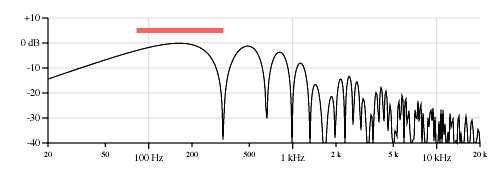
Putting this into GuitarFreak
So I had a go at reproducing the above in excel, in which string output as a voltage is dependent on:
sin (distance from bridge x frequency/scale length x open frequency x Pi)
![]()
Then I took a group of points each a short distance apart and averaged the results, which confirmed Tillmans roll-of equation above. 20 x log of all that gives me a db response.
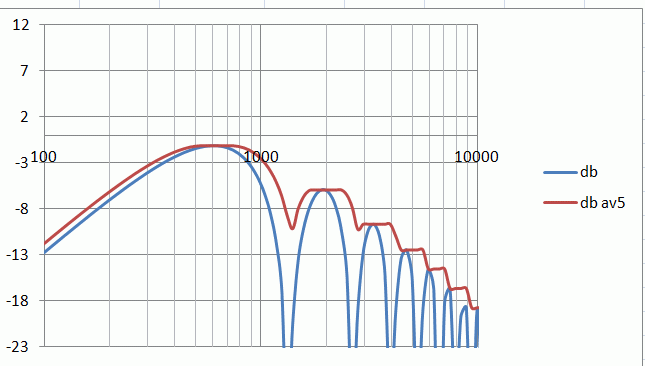
But the trouble with plots like these as with real signal traces from guitars is that they are all up and down with many peaks and nulls. For GF, inputing this would make it very hard to be able to appreciate the changes due to circuit adjustments etc, which is the basis of it. What is needed is more of an overall envelope picking up maxima, derived from the individual plots.
So what I have is an envelope derived from the maximum responses of a number of strings (user can choose up to 7). This is based on the maximum signal from any one string at a given frequency. Plus, it take a moving maximum being the highest within a range of -2 to +3 semitones. This is enough to join up all the peaks resulting in a fairly smooth curve. I included Tillmans formular for taking account of pickup sensing width.
![]()
This envelope is then taken into the main part of GF to be combined with the electrical frequency response. Here is a bridge pickup, both including the string/pickup response, or just the electrical response:
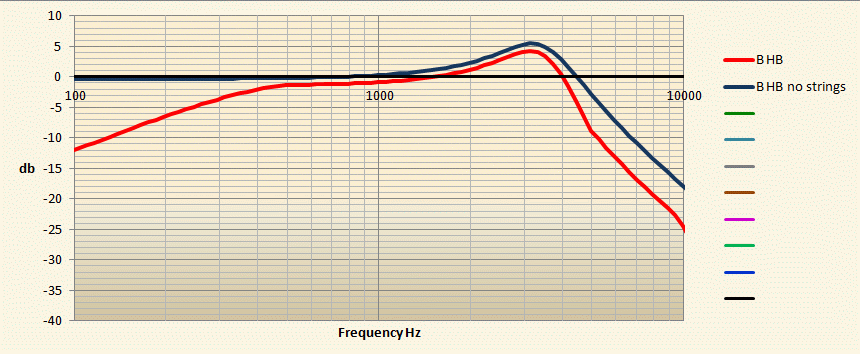
Then the fun starts when pickup combinations are included. This can be done in parallel (average output of active pickups), or series (sum of signals). The parallel combinations from each pickup are based on their relative impedances. So far, I'm just using inductance for this, since it is the dominant characteristic across most of the interesting frequencies. Phase switching is included too, and with humbuckers, local series, split and parallel wiring is included, and slant can be added to the bridge pickup
Then the final output in terms of db's v frequency, is combined with the electrical results of GF to give a final plot. Here is a Strat B and M pickup combined in various ways in and out of phase:
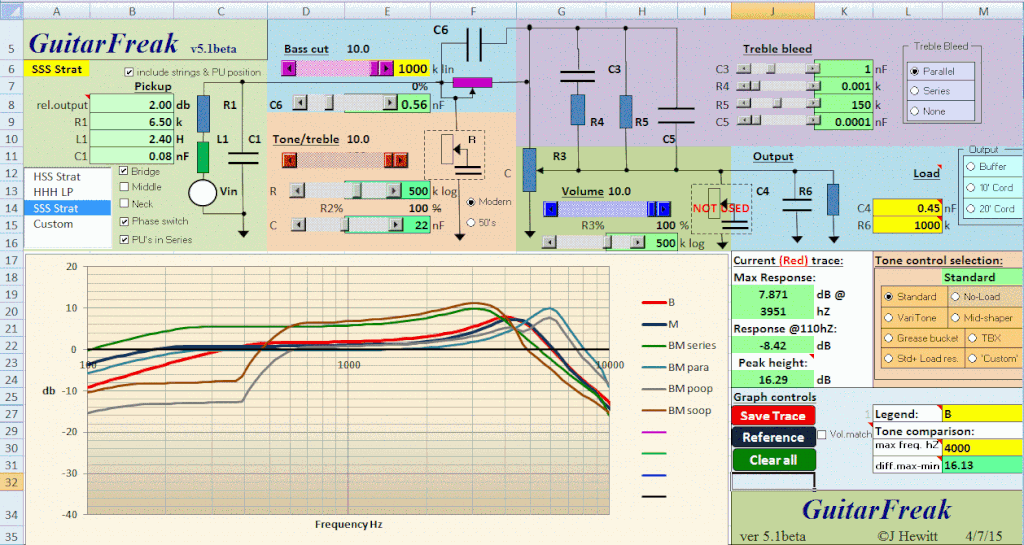
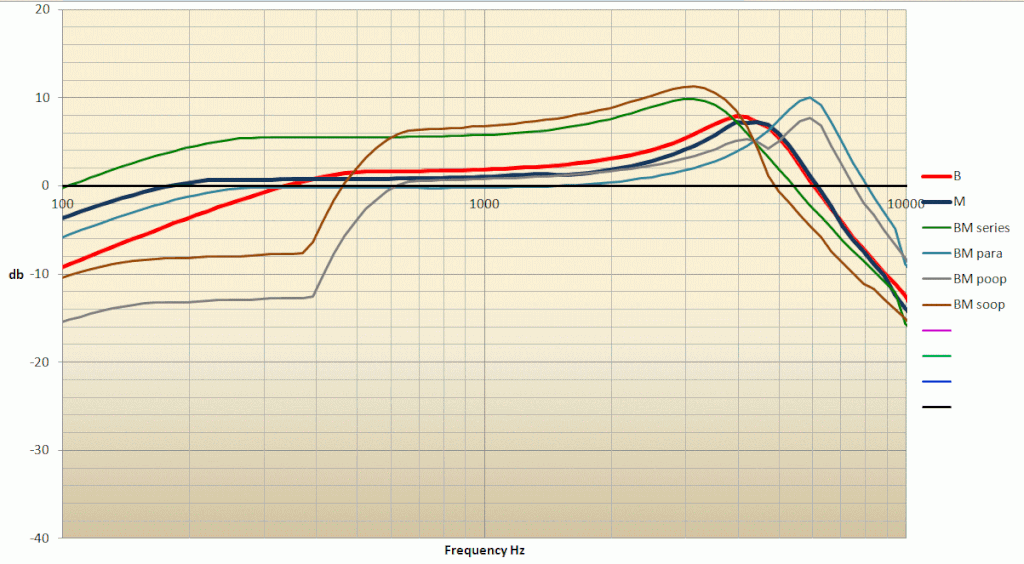
So hopefully, despite many assumptions built into all of this, the results are now at least somewhat more representative of reality, to the extent that that is possible on a single visual plot representing a complex combination of sound.
Some of the biggest assumptions are to do with the pickup characteristics themselves. Just to model them to the extent possible so far with this system, 6 parameters are needed:
1. Distance from bridge - at least that can be measured
2. Sensing width - Tillman suggest 1" and 2.5" but does not justify these. Other references suggest less.
3. Resistance - easiest to measure and the least important
4. Capacitance - hardly ever quoted but Helmuth Lemme gives some values, which can be extrapolated to others, and its not too critical
5. Inductance - very important, but only a few manufacturers quote it.
6. Output level - relative to other pickups. There is no standard for this, and only DiMarzio give values in mv , but at least that is a start and other makes can be guessed relative to DiMarzio models. We can also say the series wiring of two similar pickups adds a basic 6db, and split is -6dbetc
There is no one supplier who provides all the data - hence some of the assumed readings may be questioned and should not be taken as definitive.
Hopefully useful though, and may prove to be reasonably valid with a bit of testing.
|
|
|
|
Post by gckelloch on Aug 19, 2015 23:51:40 GMT -5
It's helpful to see those averaged spectra. Thanks for doing that. Not surprising the bridge position really rolls off the bass. Another factor not considered is the impedance response of individual pickups. Different core materials create various eddy-currents which affect impedance. Many pickups also have various losses from stretched or cracked wire insulation. GF really just shows the spectrum of ideal coils, but I find it helpful to design wiring schemes none the less.
|
|
|
|
Post by JohnH on Aug 20, 2015 2:43:50 GMT -5
It's helpful to see those averaged spectra. Thanks for doing that. Not surprising the bridge position really rolls off the bass. Another factor not considered is the impedance response of individual pickups. Different core materials create various eddy-currents which affect impedance. Many pickups also have various losses from stretched or cracked wire insulation. GF really just shows the spectrum of ideal coils, but I find it helpful to design wiring schemes none the less. Thanks for your comments. References that Ive been reading recently suggest that these eddy losses could be approximated by adding another resistor to the pickup model. If considered in parallel, some measured estimates were around 1.5M. Im sure the truth is far more complex! But if you take that as an assumption, it will make a small reduction in the peak height. Current GF has a load resistor tone option that could test it. I might build this in more comprehensively. But at the moment Ive been trying to capture more string vibration characterisics in the form of overall envelopes. The plots above include aspects of pickup position and width, but assume that all string harmonics are capable of equal output (equal string velocity). But there are equations for the harmonic bakance if a plucked string which show a greater roll-off than this. Ive been combining max envelopes of all harmonics and all strings, varrying where they are plucked, with equal force. Im finding a good match using a function with a level response up to 1 to several x the highest fundamental, then a -6db per octave roll off. That will be added to all the other effects. So the idea is that the GF system will allow string harmonics, pickups and I might add amp and speaker, to be engaged tweaked and dissenaged, along with tbe electrical parameters. Im hoping that this will result in plots that are more similar to real recorded signals, with the ability to test the influence of each idealised parameter. . |
|
|
|
Post by gckelloch on Aug 20, 2015 23:13:39 GMT -5
Different pickups have impedance humps in different ranges, so it's not just a matter of rolling off the highs. Some passive pickups even have midrange dips. Check out the “UIUC Physics 193/406 Acoustical Physics of Music/Musical Instruments Measurement of EM Properties of Electric Guitar Pickups” that shows the impedance response of a bunch of common pickups. You'd at least have to know the impedance response of your pickups to get an accurate analysis. What you've done so far is quite useful. Lofty goals you aspire to, but it may be futile to include more elements in the signal chain. It might be nice to have the ability to play modeled guitar sounds filtered by the results. It will never be quite like a real setup considering how individual guitars sound with various strings, picks, and playing technique, but hearing a representation of the analysis would be helpful.
|
|
|
|
Post by JohnH on Aug 21, 2015 19:59:00 GMT -5
Yes indeed, its a learning exercise and accuracy is difficult to achieve.
But, today I've arrived at a point where I have added some maths what may be able to approximately address one of the biggest differences left in matching calculated results to actual measured spectra, which is to do with the proportion of each harmonic in a vibrating string. This plot shows for a bridge humbucker: the pure electrical analysis, then one that incorporates a bridge pickup position and humbucker sensing width, then as above but putting each harmonic into its expected proportion (based on an envelop of all strings, assuming a certain fret and picking position), and then the same for a neck single coil (see lower two traces):
![]()
They seem to show how the usual electrical calcs overestimate the high harmonic content.
But how close to realty is this?
So I got my HSS Strat which has electrical properties that I know quite well, and modelled that, allowing for a measured cable capacitance, into a neutral buffer and mixer. Frets were capo'ed at the 3rd position and a number of strums were recorded, analysed and averaged, picking at 120mm from the bridge. Then, the traces superimposed with the calculated equivalents and levels matched:
![]()
The calculations are targeted at picking up an envelope of the overall response. The correspondence is not exact, but I think it is not bad for a first attempt. You can see the low and high roll-off of the bridge hb as compared to the neck single, in both the actual and calculated traces.
These are the first traces that I have been able to make that look anything like real spectra from a guitar, so I'm happy about that.
What's it all for? I don't know, but it is interesting and educational.
|
|
|
|
Post by gckelloch on Aug 21, 2015 21:46:40 GMT -5
That is impressive. It may prove helpful in adjusting tone stack settings--assuming the calibrations are understood. I think electric guitar players have become desensitized to the treble emphasis in high gain settings. I've adopted a practice of setting the Treble down to ~1, and boosting Presence to ~7.
|
|
|
|
Post by JohnH on Aug 26, 2015 17:17:56 GMT -5
It might be nice to have the ability to play modeled guitar sounds filtered by the results. It will never be quite like a real setup considering how individual guitars sound with various strings, picks, and playing technique, but hearing a representation of the analysis would be helpful. Ive been thinking on this, for quite a long time actually. Modelling guitar sounds is a huge technology, out of my league technically. But it would be quite easy and much more useful to do this with real guitar sounds. A guitar to be modded could be recorded cleanly as it is, into a pc using a recording software such as Audacity. Then the guitar is modelled in GuitarFreak using the best available estimates of its current parameters, and a response trace calculated. Then another trace is made with the proposed mods included. These db traces are then subtracted from each other to reveal the expected difference in tone as a db variation at each frequency This difference trace can be exported into Audacity using a simple xml format, and the expected new tones heard. This could be very realistic, because the core if what is being heard is the real sound of the guitar and only the new differences are calculated. Uncertainties in the basic guitar parameters would be largely cancelled out. |
|
|
|
Post by gckelloch on Aug 26, 2015 20:01:21 GMT -5
That's a great idea. Of course, the accuracy of the results would depend on the quality of the pickups, and the component load. Many pickups have coil semi-shorts from excess tension during winding. They can have various unpredictable losses. However, if you want to tell what your guitar will sound like with a certain filter configuration, you'd really just need to use a very low ~100pF capacitance cable when playing through the filter. You wouldn't need to bother with any other factors, and you wouldn't need the pickup inductance section in the circuit. You could even have parallel inputs for modeling combined parallel pickup sounds. That would be a useful tool for guitarists.
|
|
|
|
Post by JohnH on Sept 5, 2015 21:08:09 GMT -5
I have just uploaded a new version GuitarFreak 6.0, which includes the effects of pickup placement, sensing width, string harmonics and picking position in addition to electrical characteristics.
GuitarFreak 6.0 can be downloadd here:
GuitarFreak6.0(excel 2007)
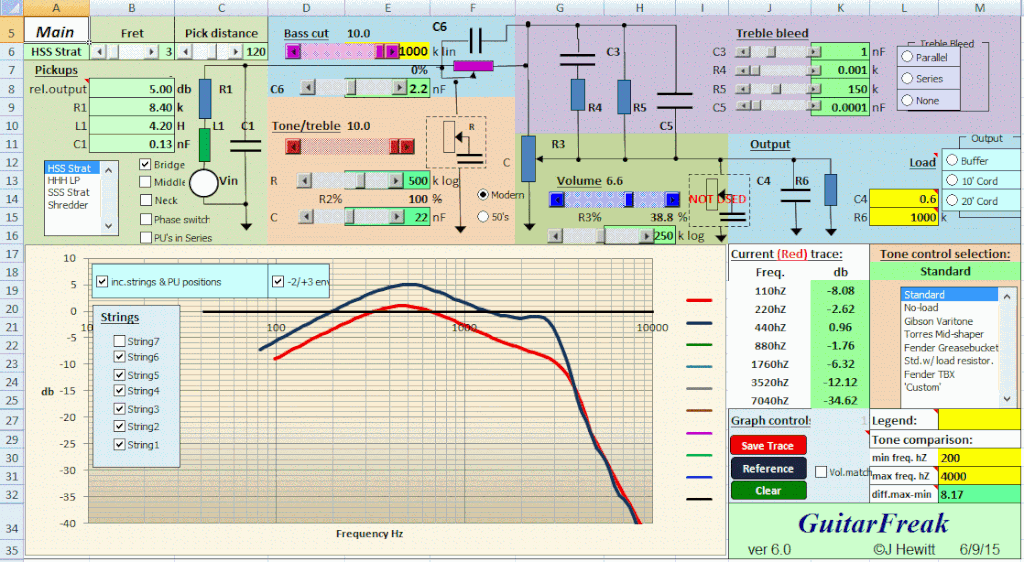
It is described in the first post on this thread, together with the previous version 5 which I will leave in place.
cheers, if anyone tries it, let me know how it goes. It was quite a learning experience for me!
John
|
|
|
|
Post by ashcatlt on Nov 25, 2015 23:53:44 GMT -5
I just realized I haven't installed OpenOffice since I "repaired" this XP install. This is, of course, because I use Google Doc, Sheets, etc now because not only does it do most of the same things for free, but it's available from any machine I happen to sit down at anywhere in the world.
That, though, led to the knowledge that this completely does not work properly in Google Sheets. This can in no way be seen as any fault of yours, JohnH. I frankly didn't really expect it to get as far as it did. I'm sure I could find which cells where I actually need to change to where to get it to give me a meaningful chart, but I'm just going to download OpenOffice instead.
Worked last time I tried. I'll let you know how this version of GF gets along with OO in a bit.
|
|
|
|
Post by JohnH on Nov 26, 2015 1:34:29 GMT -5
Well good luck! There are earlier versions posted at the end of the first post. The latest version has a lot more in it, with string harmonics, fretting position and pickup placement etc. But the core electrical modelling is the same, and I dont think Ive invoked any extra excel features. What I havnt done though is to down-save the current one to 97-2003 format. I can do that if wanted, I just cant test it properly.
Windows XP..... my grandfather used to tell me stories about that from when he was a boy...
|
|
|
|
Post by newey on Nov 26, 2015 7:27:34 GMT -5
Yes, and he had to walk 5 miles through the snow to get it . . .  |
|
|
|
Post by ashcatlt on Nov 26, 2015 11:20:56 GMT -5
I've got four XP machines, and it's getting pretty scary. I wrote a whole big thing about why I'm kind of stuck on XP, but I don't need to derail this much further. The honest truth is mostly that I never wanted to buy another OS liscence again but everything I use is windows based.
|
|
|
|
Post by cynical1 on Nov 26, 2015 11:32:11 GMT -5
Yeah, "As of April 8, 2014, support and updates for Windows XP are no longer available"... Considering it was originally released on August 24, 2001, that's over 12 years as the bread and butter OS from those guys in Redmond. IHMO, that was one of the best things they ever did. And you're never going to see them release anything that holds water for that long again...
Even though you're working without a net with XP, at least it ain't Windows 10...
HTC1
|
|
|
|
Post by sumgai on Nov 26, 2015 11:56:17 GMT -5
And you're never going to see them release anything that holds water for that long again... Water? Hold water?  I want sumpin' that can hold its likker!  [/end derailment] |
|
|
|
Post by JohnH on Apr 9, 2016 5:41:26 GMT -5
GuitarFreak - Latest version 6.3The latest version of GuitarFreak is version 6.3. It has the same scope as version 6.0, with the addition of a 'Full Response' setting which shows the individual separate harmonics of each active string, as influenced by pickups, fretting and picking position plus electronics. Alternatively, overall envelopes can be shown, or just the pure electrical response. Internally, I have also changed the way strings are combined to create envelopes, giving a more consistent output. This is how it now looks, it can be downloaded at the links below: 
The previous version 6.0 added representations of pickup placement, string harmonics and picking position to GuitarFreak, to combine with the electrical calculations that were in earlier versions.
Download links for version 6.3:
GuitarFreak6.3(excel 2007)
GuitarFreak6.3(excel 97-2003)
See also, the first post on page 1 of this thread (which is overdue for a complete do-over rewrite, hopefully sometime soon).
John
|
|
tonqu
Rookie Solder Flinger

Posts: 2 
Likes: 0
|
Post by tonqu on Jul 17, 2016 2:48:07 GMT -5
Hi John, Unfortunately download links are not working. Can I download this from somewhere else please?
Regards,
Tonqu
|
|
Deleted
Deleted Member
Posts: 0
Likes:
|
Post by Deleted on Jul 22, 2016 21:39:50 GMT -5
John,
All the links to GuitarFreak, with the exception of V1, seem to be dead. Is it still available?
|
|
|
|
Post by JohnH on Jul 22, 2016 21:50:00 GMT -5
yes it will be, in a few minutes. My ISP actually deleted all our website files, but Ill put it back, version 6.3 EDIT: these links are now OK: Current Versions: GuitarFreak 6.3GuitarFreak6.3(excel 2007)GuitarFreak6.3(excel 97-2003)ps - I'm very much still into developing this. The next feature will be a more sophisticated pickup model, based on test measurements being made on the StratTalk forum. This will allow differences between specific and generic pickups to be much better represented to reveal more of the differences between humbuckers and singles, and different models and makes, the effect of covers, eddy current damping etc. Its fascinating stuff, coming soon. |
|
tonqu
Rookie Solder Flinger

Posts: 2 
Likes: 0
|
Post by tonqu on Jul 25, 2016 6:53:38 GMT -5
Many thanks John!
|
|
meatportal
Rookie Solder Flinger

Posts: 1 
Likes: 0
|
Post by meatportal on Aug 19, 2016 11:14:09 GMT -5
It appears that the www.jocidapark.com.au links are not working... anyone have a working link for v 6.3? thanks! |
|
|
|
Post by JohnH on Aug 19, 2016 15:48:22 GMT -5
It appears that the www.jocidapark.com.au links are not working... anyone have a working link for v 6.3? thanks! Try again now. The place where it is hosted 000webhost, seems to delete my site at random intervals for reasons unknown. Should be ok now, but I'll update the links again when I have moved to a more reliable provider. But while you are here, and in return for access to my spreadsheet, I'd be interested in any comments and feedback such as what you would like to use it for, what are you running it on (excel or another program?), and if you find it not too hard to use? BTW v6.4 is nearly ready - which has much more accurate pickup modelling based on bench testing a range of pickups cheers and welcome J |
|
|
|
Post by JohnH on Aug 22, 2016 3:01:44 GMT -5
GuitarFreak 6.4 is now online, and based on a range of considerably more accurate pickup models These were derived based on tests on the Strattalk forum (thanks particularly Antigua on ST) The tests were used to derive models of real pickups that allow for damping and the more subtle changes in response as loading is varried. It can now show things like how different alnico single coils might vary, or a coil-cut humbucker might differ from a true single. www.jocidapark.com.au/circuits/GuitarFreak_6_40_210816.xlsmwww.jocidapark.com.au/circuits/GuitarFreak_6_40_210816.xlsThose are Excel 2007 and Excel 97-2003 versions. Here's how it looks:  As plotted, you see the loaded electrical response of a Fender 57/62 and an SSL1, then the SSL1 with an envelope of actual output based on the bridge position, then in red, the full output with all harmonics etc. Have a play! and comments will be very much appreciated. Suggestion: Dont worry about all the detail, just try the menu selections, slide the sliders, press the buttons etc. Coloured sliders are the guitar knobs, grey sliders are mostly component values. Anything with a yellow box can be typed directly into. The 'Save' 'Reference' and 'Clear' buttons, with the yellow 'Legend' box allow multiple plots to be built up. Other pages set up more specifics about tone controls (multiple types) and pickups. There are over 20 currently loaded based on Antiguas data, with space for up to 40. Ill add more over time. |
|
|
|
Post by JohnH on Sept 3, 2016 20:23:30 GMT -5
I just updated the first page on this thread, with a rewrite for GuitarFreak 6.4. New features of GuitarFreak include: - A native version in free open-source .ods format, using LibreCalc, in addition to two Excel versions
- A step-by step quick-start guide
- Much better pickup models
I hope it will work for you, and be accessible and understandable to more people. I am grateful for comments. cheers John |
|
|
|
Post by perfboardpatcher on Oct 15, 2016 7:50:02 GMT -5
John, I wanted to report some problem I'm experiencing in Guitarfreak_6_41_270816.ods under Linux. When pressing "Reference", "Save Trace" or "Clear" on the Main sheet I get the following error message: 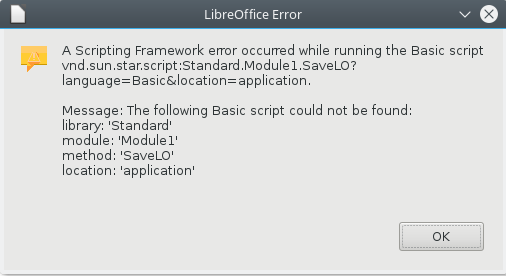 If this is the location there is nothing to be found: 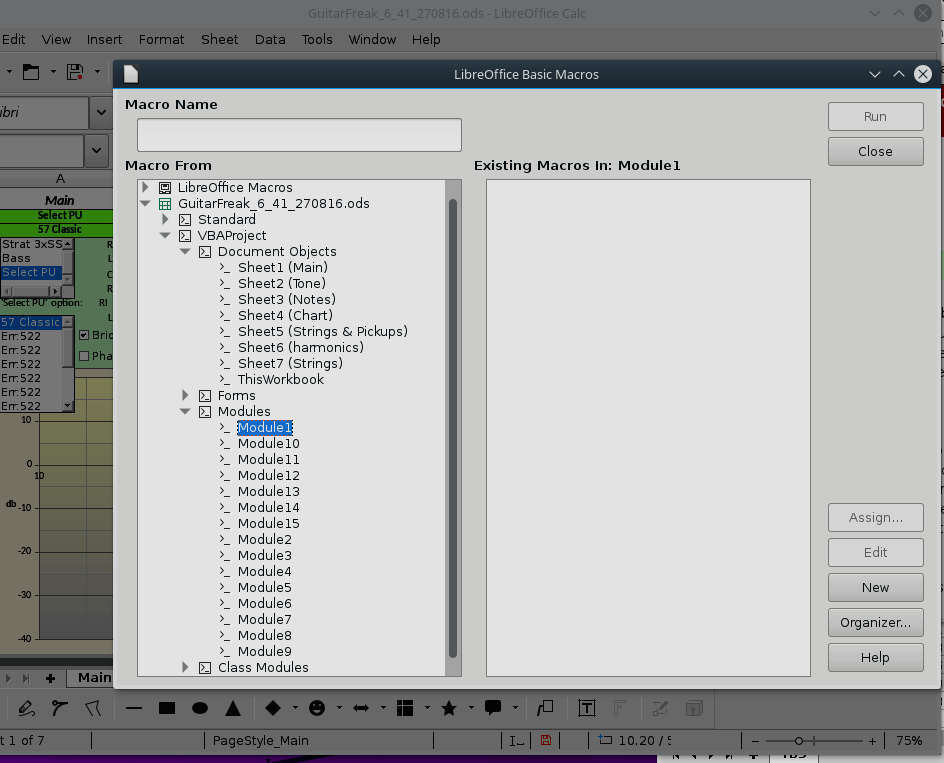 Not exactly a man overboard but I thought you would like to know. Some other minor detail: Err:522 in the browse list for Pickups (with iteration on I get Err:523) although browsing and selecting a pickup works. I searched and found this. |
|
|
|
Post by JohnH on Oct 15, 2016 15:23:34 GMT -5
Thanks pbp. much appreciated!
I may have fixed the 'Save' and 'Reference' issues, by re-recording them. It seems that unlike Excel, LO requires a copied range to be cleared before pasting to a new range. An updated version is now on the same link as before on post 1 of this thread. Id be very grateful if you would give it a try.
I don't know about the menu issue, I'm not seeing that here. I'm running LO 5.2 with Windows10, whereas you are running Linux. Could there be any issue there?
I have a small update coming soon, its the same functionality and structure but with more slots for pickup and guitar selections and some extra pickups that I have added recently.
|
|
|
|
Post by perfboardpatcher on Oct 17, 2016 13:18:36 GMT -5
Thanks pbp. much appreciated! I may have fixed the 'Save' and 'Reference' issues, by re-recording them. It seems that unlike Excel, LO requires a copied range to be cleared before pasting to a new range. An updated version is now on the same link as before on post 1 of this thread. Id be very grateful if you would give it a try. I don't know about the menu issue, I'm not seeing that here. I'm running LO 5.2 with Windows10, whereas you are running Linux. Could there be any issue there? I have a small update coming soon, its the same functionality and structure but with more slots for pickup and guitar selections and some extra pickups that I have added recently. It's definitely a compatibility issue! I've tried the latest version of Guitarfreak and the same errors popped up. If I run the macro called Ref I get a basic runtime error. I will try Guitarfreak on my laptop. Thanks anyway! |
|
|
|
Post by perfboardpatcher on Oct 22, 2016 3:17:16 GMT -5
As promised, I tested Guitarfreak_6_41_161016.ods in LibreOffice under Windows and got the same results with regards to the 3 buttons on the main sheet. LibreOffice looks for the buttons in Module1 but "clear" is in Module10, "ref" is in Module11, there's no match for "save" or "save trace".
|
|